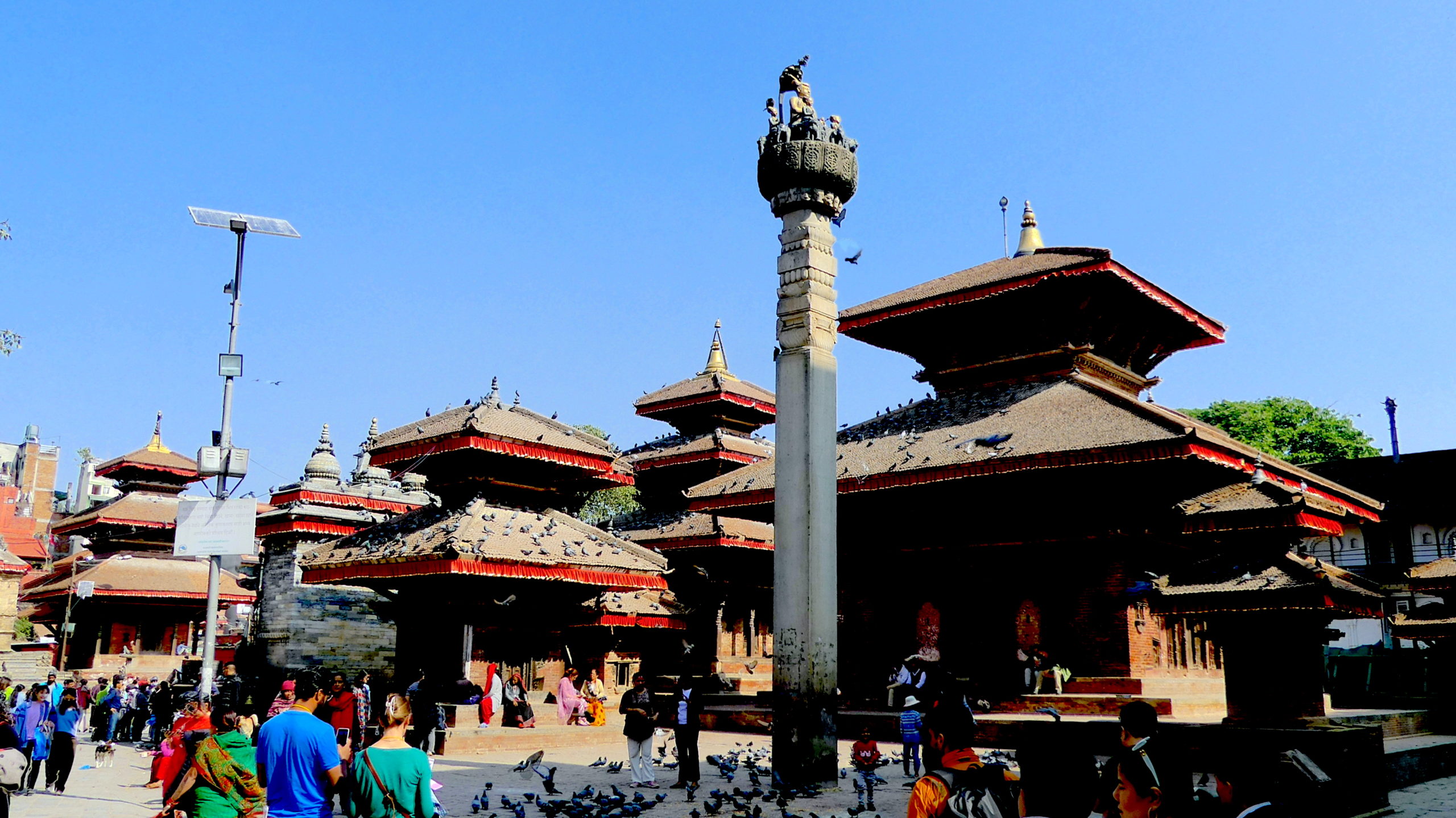Kathmandu Durbar Square Day Tour
fromOne of Kathmandu’s most prominent sights, Kathmandu Durbar Square also known as “Basantapur Durbar Square” or “Hanuman Dhoka Durbar Square,” is a short stroll from Thamel, the city’s well-known tourist hub. Since 1979, the location has been acknowledged by UNESCO as a World Heritage Site. It is an interesting destination to visit because of its historical significance, lovely z, and bustling bazaars (market). The Malla and Shah monarchs used to be crowned in Kathmandu Durbar Square.
Kasthamandap, a structure from the seventh century that is located in Durbar Square, is where Kathmandu got its name (unfortunately, Kasthamandap was destroyed by the April 2015 Earthquake). It is thought that the Durbar Square was built sometime during the Licchavi era, which was in the third century. However, during the 13th through the 18th centuries, the Malla monarchs constructed the majority of the temples, structures, and monuments.
-
Reviews 0 Reviews0/5
-
Vacation Style Holiday Type
-
Activity Level Fairly Easy
-
Group Size Medium Group
We begin our tour by entering the Square and heading directly to the Kumari Ghar.
The Kumari Ghar
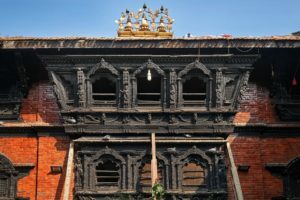 It is among the most well-known structures in Kathmandu and a key factor in drawing visitors to Durbar Square.
It is among the most well-known structures in Kathmandu and a key factor in drawing visitors to Durbar Square.
The Living Goddess Kumari, a manifestation of Goddess Taleju, resides at the Kumari Ghar. Each of Kathmandu, Patan, and Bhaktapur has its own Kumari, with the Royal Kumari in Kathmandu Durbar Square being the most significant one. During the reign of King Jayaprakash Malla in 1757, the Kumari tradition was formally established. However, the custom may have begun earlier, perhaps around the 16th century and King Trailokya Malla’s reign.
According to a tale, a young girl of the Newar Shakya caste represents the spirit of Goddess Taleju. The Kumaris are said to have the Goddess residing within them till puberty. The tiny girl returns to normal life after the Goddess leaves the Kumari’s body, and a new Kumari must be chosen. The highest priests decide who gets chosen. The “32 Attributes of Perfection” (Battis Lakshanas), a unique rite, is used to select the Kumari.
The Kumari, who resides in the Kumari Ghar with her caretakers, only leaves the building during certain Kathmandu religious events. Even though she occasionally leaves her palace, she never steps foot outdoors. She is only permitted to communicate with her family and caregivers and is unable to interact with anybody else.
We will visit the inner courtyard of Kumari Ghar. The Living Goddess Kumari shows herself at the central window.
Exiting the Kumari Ghar, we will enter the main complex of the square to see Kaal Bhairav and Sweta Bhairav.
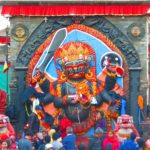
Kaal Bhairav
The massive statue of Lord Shiva’s ferocious manifestation, Kaal Bhairav, was created in the fifth or sixth century and later unearthed in the seventeenth century. The installation of this monument as a supreme court occurred during the reign of King Pratap Malla. For a very long time, it was thought that those who lay in front of the monument would pass away.
In order to get the truth out of the suspects, the formidable Kaal Bhairav was summoned into the room.
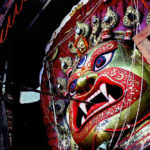
Sweta Bhairava
Sweta Bhairava is a representation of Lord Shiva’s grotesque appearance. During the reign of King Rana Bahadur Shah in 1795, it was erected inside Durbar Square. The mask is only displayed during the Indra Jatra celebration in September and is kept concealed behind a wooden curtain for the rest of the year.
Although we have told your stories through this blog, we will hear them from the locals there to make it more lively and give you the sensation of reliving history. After watching those two sculptures, we will head to the Shiva Parvati Temple.
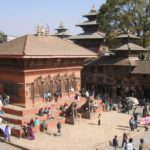
Shiva Parvati Temple
Shiva and his wife Parvati are honored in the magnificent Shiva Parvati Temple. It was constructed in the late 18th century under the rule of King Rana Bahadur Shah, Prithvi Narayan Shah’s grandson. Shiva and Parvati are depicted in two wooden sculptures that stand in front of the temple’s open central window on the first floor.
Taking our blessing from the temple, we will head to Taleju Bhawani Temple.
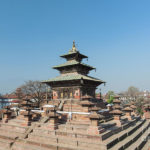
Taleju Bhawani Temple
The Goddess Taleju Bhawani, the Royal deity of the Malla Kings, inspired the construction of the Taleju temple, which was finished in 1564. One of the most stunning temples in Kathmandu Durbar Square, Taleju Bhawani, is still standing. Unfortunately, the public cannot enter the temple. Non-Hindus are not permitted inside the temple; they may only see it from the outside. Hindus are permitted to visit the temple once a year on the ninth day of Dashain.
Now, we will head to the Akash Bhairav Temple
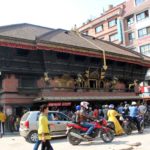
Akash Bhairav Temple
The Akash Bhairav temple is a stunning bronze and gold structure that honors Akash Bhairav, another name for Bhairava and the God of the Sky. The first king of Nepal, King Yalambar, is thought to have lived in the Akash Bhairav temple between 3,100 and 3,500 years ago. Once a year, at the festival of Indra Jatra, the head of Akash Bhairav is removed from the temple and blessed by the Living Goddess Kumari.
After the temples, we will have some food and prepare ourselves for the main event: Hanuman Dhoka Palace!
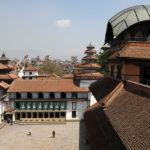
Hanuman Dhoka statue
Before entering the palace, we shall come across a statue: a red statue of the Hindu monkey god Hanuman, which is now the entryway of the Hanuman Dhoka Museum, situated at the Hanuman Royal Palace’s entrance. “Dhoka” means door in Nepali.
While King Pratap Malla was in power, the statue was placed at the palace’s gate in 1672.
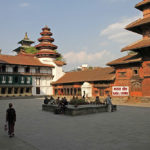
Nasal Chowk
The Hanuman Dhoka Palace’s courtyard is known as Nasal Chowk. The Nepali Kings’ coronations took place there. The coronations of Nepal’s kings, such as King Birendra Bir Bikram Shah in 1975 and King Gyanendra Bir Bikram Shah in 2001, continued to be conducted in Nasal Chowk until the end of the monarchy in 2008.
However, Hanuman Dhoka was no longer the official royal palace after 1896.
 Hanuman Dhoka Palace Museum
Hanuman Dhoka Palace Museum
The Hanuman Dhoka Palace Museum, which is located inside the palace, was destroyed in the 2015 earthquake. The palace was later opened to visitors, however, some portions are still off-limits. The entrance to the Hanuman Dhoka museum, also known as the Tribhuvan Museum, is included in your Kathmandu Durbar Square ticket, and it displays relics relating to the Nepalese monarchy.
After spending our time observing all the historically and culturally important emblems we will resume our exploration by visiting Jagannath Temple.

Jagannath temple
One of the oldest temples in Kathmandu Durbar Square is the Jagannath Temple (probably dating back to 1563). The temple’s sexual carvings are its main claim to fame. Tourists and locals alike frequently feed pigeons on the big platform in front of the shrine. In front of the two-story temple presently stands the restored King Pratap Malla column.
Giant drums and a large bell would be visible as we traveled. These objects also have backstories. During the time of Rana Bahadur Shah, the Goddess Taleju was worshiped with two enormous drums and a massive bronze bell. Important notifications and alarms were also made using these drums. They are currently on view on a platform next to the Krishna temple.
Crossing our paths, and filling ourselves with stories, we continue our exploration. We stop to witness Gaddi Baithak.
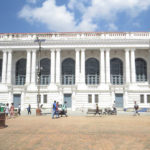 Gaddi Baithak
Gaddi Baithak
Rana Prime Minister Chandra Shamsher constructed the white neo-classical Gaddi Baithak in 1908. The building was harmed by the earthquake in April 2015, although it has already been repaired. Currently, there is no entrance permitted within the structure. However, it’s been said that shortly, guided tours would be offered, and the ground floor will hold a museum.
Located nearby is Kasthamandap – our next destination.
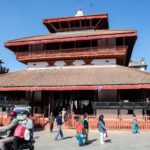 Kasthamandap
Kasthamandap
The Gorakshanath shrine is located inside Kasthamandap, a public wood pavilion that serves as a refuge for pilgrims but is not a temple. A single sal tree’s wood was used to construct it sometime in the 12th century. This structure bears the name of the city of Kathmandu.
Now, we will be looking to exit Durbar Square, but we will stop by Basantapur Square to see everything people are selling there in the open air.
Basantapur square
Basantapur Square is occupied by a sizable open market. There, you’ll discover a wide range of antique, jewelry, and handmade goods.

Freak Street
When marijuana was still legal in Nepal in the 1960s and 1970s, Freak Street, also known as Jhochhen Tole, became famous. Freak Street, which is south of Kathmandu Durbar Square, has undergone a significant transformation, yet some of the stores are still worthwhile stopping by.
Leaving Durbar Square to end our tour, we will head to Ason.
Ason, Kathmandu’s local market
The finest place to get authentic local food, spices, fabrics, jewelry, and so much more is at the famous local market known as “Ason.” We will walk around the streets and if anything catches your eye, you can buy it.
From Ason, we will return and by that time, it will already be evening.
